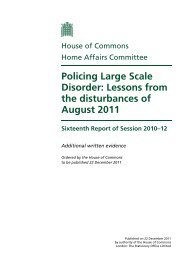Murder and Serious Sexual Assault - Lancaster EPrints - Lancaster ...
Murder and Serious Sexual Assault - Lancaster EPrints - Lancaster ...
Murder and Serious Sexual Assault - Lancaster EPrints - Lancaster ...
You also want an ePaper? Increase the reach of your titles
YUMPU automatically turns print PDFs into web optimized ePapers that Google loves.
RISK FACTORS AND RELATIONSHIPS IN MURDER<br />
burglary (other than in a dwelling), stealing by an employee <strong>and</strong> theft from<br />
automated machines all increase the risk of an acquaintance murder. The risk also<br />
increases for a greater number of previous custodial sentences. These variables did<br />
not seem to increase the risk of a conviction for murdering an acquaintance when<br />
compared against a control group made up of the general run of offenders. Only<br />
when the focus is on violent offenders do these factors make significant differences.<br />
While not identical, these findings share some similarities with the two analyses<br />
that were carried out for all murderers in Chapter 3. This is not completely<br />
surprising, since acquaintance murders form the largest sub-set of murderers, <strong>and</strong><br />
there will naturally be a bias in this group’s favour.<br />
A different picture emerges for those convicted of murder of a male stranger. Here,<br />
several of the risk factors, including custody in the previous criminal history <strong>and</strong><br />
previous convictions for burglary (in a dwelling), robbery, kidnapping or arson,<br />
remain from the analysis using general offenders as controls (Table 10). This<br />
suggests that these factors indicate an increased risk of murder of a male stranger,<br />
rather than violence in general. Additional factors which significantly increase the<br />
risk of murder of a male stranger when compared to violent offenders include<br />
convictions for criminal activity between the ages of ten <strong>and</strong> 15, <strong>and</strong> the number of<br />
sentencing occasions where a custodial sentence was given.<br />
In summary, the variables that emerged as risk factors for the various types of murder<br />
were largely found to be those identified as increasing the risk of murder in general.<br />
What is new is that the same variables do not often emerge for each of the four<br />
different types of offender-victim relationship. Those with a history of acquisitive<br />
crime <strong>and</strong> with greater numbers of convictions were less likely to become family<br />
murderers. Very few factors significantly affect the risk of murder of a female<br />
stranger, due to the small numbers of cases involved. Meanwhile, the risk factors for<br />
murders of acquaintances or male strangers varied depending on whether general or<br />
violent offenders were used as the control group. Nevertheless, those factors that did<br />
appear were largely those that significantly increase the risk of overall murder.<br />
While the proportions of those having previous convictions did not differ<br />
significantly between the different types of offender-victim relationships (see Table<br />
9), the profiles of the previous criminal history was far from uniform.<br />
32
















